1 . Plants, and the insects which rely on them, are the living foundations of our planet. But these foundations are under stress because we have a tendency to replace fields and forests with decorative trees and shrubs imported from around the world. Adding to the problem, our obsession (痴迷) with perfection leads us to use a lot of pesticides (杀虫剂).
These actions are part of the reason global biodiversity is crashing. There are over three billion fewer wild birds in North America than there were in 1970. Recent research shows that insect numbers, even in nature reserves, have fallen, and 40 percent of all insect species may be extinct within a few decades. This is discouraging news; however, there are actions we can take to help bring at least some species back.
The first step is to redefine our concept of “garden” to include more than just plants. We need to intentionally share our space, and not just with the birds, bees and butterflies that visit our flowers, but also with the little insects that may eat a part (very rarely all) of our plants. Therefore, we must limit pesticide use. It’s crucial to support nature’s recovery, and it’s much better for everyone: no doctor has ever recommended long-term exposure to pesticides.
Many drought-tolerant plants brought in from across the planet are being passed off as ecofriendly. However, mostly they’re not. Yes, you’re saving water, but these foreign plants can become disasters when they escape our yards. Helping the environment can be about more than saving water. Even in drier areas, like the American West, the selection of attractive native plants to choose from is vast. If dry is your style, there are native wildflowers, flowering bushes and trees that allow you to save water and nature.
Xeriscapes (节水型园艺) leave many gardeners thirsting for green, and there’s an important alternative that has been largely ignored. For those disenchanted with dry landscaping, using underappreciated and water-loving native plants to make your garden a real-life oasis (绿洲) could be lifesaving to wildlife. In nature, this unsung group of native plants is limited to riparian zones, the narrow belts of green along water bodies, but if consumers demand them, nurseries will increasingly carry these riparian species, and the presence of such plants in the garden will provide for many animals including not just butterflies and their relatives but also colorful birds.
The ideal garden would offer a combination of drought-tolerant native plants and a few species that need a little more water, providing options for little guests and the bigger ones that will come to eat them. As more creatures stop by to share our yards, we will be making nature, and us all, a little healthier.
1. What do we know about insect species?| A.They have an impact on the diversity of plants. |
| B.They disappear because of lack of nature reserves. |
| C.They decrease partly due to our pursuit for perfection. |
| D.They are the reason why we replace fields and forests. |
| A.sick of | B.addicted to |
| C.concerned about | D.impatient with |
| A.why we need grow native plants in gardens |
| B.how gardening helps with biodiversity |
| C.whether we should redefine “garden” |
| D.what benefits gardening brings |
CP: Central Point P: Point Sp: Sub-point C: Conclusion
A. | B. |
C. | D. |
2 . Humans’ overconsumption of resources is a leading contributor to global climate change, says University of Arizona researcher Sabrina Helm. Therefore, it’s increasingly important to understand the choices consumers make and how those decisions affect the health of a planet with limited resources. In a new study, published in the journal Young Consumers, Helm and her colleagues explore how materialistic values influence pro-environmental behaviors in millennials, who are now the nation’s most influential group of consumers.
The researchers focused on two main categories of pro-environmental behaviors: reduced consumption, which includes actions like repairing instead of replacing older items; and “green buying,” or purchasing products designed to limit environmental impacts. The researchers also looked at how engaging in pro-environmental behaviors affects consumer well-being.
More materialistic participants, the researchers found, were unlikely to engage in reduced consumption. However, materialism did not seem to have an effect on their likelihood of practicing “green buying.” That’s probably because “green buying,” unlike reduced consumption, still offers a way for materialists to fulfill their desire to get new items, Helm said.
Study participants who reported having fewer materialistic values were much more likely to engage in reduced consumption. Consuming less was, in turn, linked to higher personal well-being and lower psychological suffering. Green buying—which may have some positive environmental effects, although to a smaller degree than reduced consumption—was not found to improve consumer well-being, Helm said.
The take-home message for consumers: “The key is to reduce consumption and not just buy green stuff. Having less and buying less can actually make us more satisfied and happier,” Helm said. “If you have a lot of stuff, you have a lot on your mind,” she said. “For example, it requires maintenance and there’s a lot of burdens of ownership, and if you relieve yourself of that burden of ownership, most people report feeling a lot better and freer.”
Helm and her colleagues additionally looked at how materialism affects millennial consumers’ proactive financial behaviors, such as budgeting and saving. Examining financial behaviors alongside pro-environmental behaviors provides a picture of how young adults proactively deal with resource limitations in two contexts: environmental and financial, Helm said.
As expected, Helm and her colleagues found that those who reported having more materialistic values engaged in fewer proactive financial behaviors than their less materialistic counterparts (对应的人). The researchers also found that, consistent with previous studies, proactive financial behaviors were associated with better personal well-being, life satisfaction and financial satisfaction, as well as lower psychological suffering.
Understanding how materialistic values impact consumer behaviors, and how those behaviors in turn affect personal and environmental well-being, is important, Helm said. However, she acknowledges that for many consumers, shifting behaviors to be more financially proactive and consume less will be challenging.
1. What do we know about pro-environmental behaviors?| A.They are a cause of climate change. |
| B.They lead to a more satisfying life. |
| C.They vary in different age groups. |
| D.They are affected by materialism. |
| A.ownership of green products brings a sense of happiness |
| B.materialists prefer practicing green buying to buying less |
| C.green buying helps control people’s desire to buy new items |
| D.buying less and green buying have similar effects on people |
| A.Replacing older items. | B.Developing new resources. |
| C.Buying greener products. | D.Being careful with expenses. |
| A.When people develop proactive financial behaviors. |
| B.Which financial behaviors lead to mental well-being. |
| C.Why it is hard to change people’s financial behaviors. |
| D.How materialistic values influence financial behaviors. |
3 . The new Blackfriars train station in London is a great building, giving passengers wonderful views of the city. However, they will hardly see most of London's best-known landmarks, for today they are lost in a jungle of skyscrapers, as if London were competing with Dubai (迪拜).
The new look is dull. The problem isn't modern architecture itself. When the modern combines the old, it can enhance a city. But when it has no connection to the features that have given the city its personality for hundreds of years, it overshadows that city's character.
Unattractive architectural style is one thing; unsuitable location is another. The City, London's traditional financial district, was an area of strong low-rise buildings that included old houses and pubs such as the George and Vulture, which counted Charles Dickens among its frequent customers. The glass large buildings are quickly destroying the City's character. Dutch architect Rem Koolhaas says the architectural style of cities is converging (趋同).
London is not alone. Paris is getting into the skyscraper game, as are other European capitals. Government officials view very tall buildings as global status symbols. Celebrity architects are in high demand and pump out designs apparently aimed more at attracting attention than enhancing a city's traditional view. Some of their creations are imaginative, stylish and practical; some are not, or are fine creations put at the wrong address.
The process of turning big cities into clones of Atlanta or Hong Kong can create more than strange cityscapes. They create long-term problems as well One is environmental. Skyscrapers require huge amounts of energy all year round for heating and air conditioning. Many old buildings in Europe simply rely on thick walls to ward off the heat in the summer and keep the heat in the winter.
Another big problem with modern high-rises is that they are single-purpose structures. Bank towers with huge open trading floors wired to the fastest communications networks cannot be easily remade into housing, factories or shops. For the most part, they will have to be torn down when they have outlived their usefulness. In Europe, strong old buildings keep getting reinvented, century after century. An 18th-century church can be changed into a hospital.
All in all, the main shortcoming of the skyscraper craze is the loss of urban identity. Millions of tourists go to Rome, Florence, Paris, because, for the most part, they have not been "liberated" yet by towers. If these cities look like Dubai, who will want to go there? Not me.
1. The writer thinks that __________.| A.the new Blackfriars station damages the image of London |
| B.skyscrapers make it easy to see London's landmarks |
| C.too many high buildings damage a city’s identity |
| D.historical houses and pubs are well preserved |
| A.it's a trend to build skyscrapers worldwide |
| B.tall buildings are designed to be eco-friendly |
| C.European capitals stick to their old city styles |
| D.citizens view high-rises as global status symbols |
| A.When Skyscrapers Can Save the City |
| B.How Cities Can Build a Cultural Identity |
| C.Why Skyscrapers Are Killing Great Cities |
| D.What Landmarks Are and Why They Are Important |
A. | B. | C. | D. |
4 . Many people think that communication is the source of most of their work-related conflicts but they'd be wrong. In a work context, more conflicts come from structural relationships and personal differences than communication itself.
Organizations create job descriptions, specialized work groups, and authority relationships, all with the intent to improve coordination (协调). But in doing so, they separate people and create the potential for conflicts. For instance, departments within organizations have diverse goals. Purchasing is concerned with the timely acquisition of materials and supplies at low prices; quality control's attention is focused on improving quality and ensuring that the organization's products meet standard…When groups within an organization seek diverse ends, there is increased potential for conflicts.
Have you ever met people to whom you took an immediate disliking? Most of the opinions they expressed, you disagreed with. Even insignificant characteristics-the way they cocked their head when they talked or smirked when they smiled-annoyed you. We've all met people like that, and many of us have to work with people like this.
Today's organizations are increasingly diverse in terms of age, gender and race. So, not surprisingly, employees differ on the importance they place on general values such as responsibility, equality and ambition. They also differ on job-related values such as the importance of family over work or freedom against authority. These differences often surface in work-related interactions and create significant interpersonal conflicts.
The above doesn't mean that communication can't be a source of conflicts. It can. Differing word connotations, insufficient exchange of information, poor listening skills, and the like, create conflicts. But the belief that “we can deal with our differences if we just communicate more” is not necessarily true. The evidence actually shows that the potential for conflicts increases when there is too much communication as well as when there's too little.
So when you're trying to manage conflicts, take a thoughtful look at their source. It's more likely that the conflict is coming from work-related requirements, personality differences, or dissimilar values, it is from poor communication. And that might influence the actions you take to resolve the conflict.
1. From Para.2, we know that in an organization, __________.| A.job descriptions can effectively improve cooperation |
| B.different goals of branches may cause disagreements |
| C.division of labor usually results inharmonious relationship |
| D.the setting of different departments is to encourage competition |
| A.fewer conflicts will appear if we communicate more |
| B.most people share similar values in the same organization |
| C.communication is just one of the reasons for most conflicts |
| D.we'd better calm down before taking action when in conflict |
A. | B.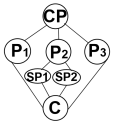 |
C.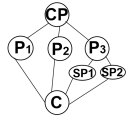 | D. |
5 . The Impossible Burger is entirely free of meat. But it looks, smells, feels and-most importantly-tastes so much like real hamburger beef. In fact, plant-based burger alternatives have set off a strong resistance from the beef industry. The Center for Consumer Freedom, a nonprofit that advocates on behalf of the fast food and meat industries has launched an "informational" campaign targeting plant-based meats. The campaign has included TV and online ads, as well as print ads in newspapers. The ads seem to imply that not only is an artificial burger too processed, but that it might be even less healthy than the average beef burger.
While it's true that a plant-based meat alternative is processed and it's true that eating one is not as healthy as a pile of raw vegetables, it's best to take the ads with a generous pinch of salt.
For instance, the additives and preservatives in plant-based meat highlighted in one ad sure sound scary. Who wants something called titanium dioxide(二氧化钛)in their meal? But the truth is that additives such as those listed in the ads are regularly used in all sorts of packaged foods. And if methylcellulose, a food thickener, sounds unpleasant, it's really nothing compared with salmonella(沙门菌)poisoning you can get from regular meat.
Also, the ad campaign misses the bigger point. Choosing an Impossible or Beyond burger isn't just about healthy eating Burgers, whether they are made from processed pea protein or processed meat, will never be as healthy as organic raw vegetables.
What's appealing is the prospect or enjoying a juicy burger without the bitter aftertaste of guilt.
Let's face it, there are huge environmental costs to eating cows. Cattle raising is contributing to climate. change, and not just because methane(甲烷)from cows and cattle is responsible for about 14.5% of greenhouse gas. More broadly, our global food production system releases more than a third of the world's greenhouse gases. Yet we can't seem to control our meat appetite even knowing that large areas of the Amazon forest have been ruined, and continue to be cut down to make room for more cattle to feed the growing demand for beef. Humans also know full well that many animals live short, cruel lives in awful conditions for the purpose of becoming foods for humans to enjoy at dinner.
A plant-based meat that satisfies meat desires and delivers protein but with a smaller climate footprint is a potential environmental game changer and the reason Impossible Foods was one of those receiving the UN, Global Climate Action Award in 2019. No wonder the meat industry is on guard.
1. What does the underlined sentence in Paragraph 2 most probably mean?| A.These ads deserve little consideration. |
| B.We should spread the message of these ads. |
| C.These ads tell people a lot about plant-based burgers. |
| D.We'd better be cautious when reading these ads |
| A.Their use is within the normal range. |
| B.They are likely to cause poisoning. |
| C.They are used to ensure burgers taste good |
| D.Some have not been used in hamburgers. |
| A.Doubtful | B.Supportive | C.Disapproving. | D.Neutral |
I: Introduction P: Point Sp: Sub-point(次要点) C: Conclusion
A.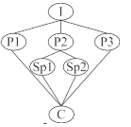 | B.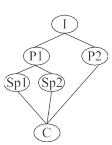 |
C.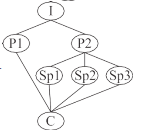 | D.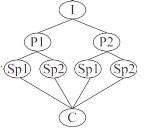 |
6 . As online learning becomes more common and more and more resources are converted to digital form, some people have suggested that public libraries should be shut down and, in their place, everyone should be given an iPad with an e-reader subscription.
Supporters of this idea state that it will save local cities and towns money because libraries are expensive to maintain. They also believe it will encourage more people to read because they won't have to travel to a library to get a book; they can simply click on what they want to read and read it from wherever they are.
However, it would be a serious mistake to replace libraries with tablets. First, digital books and resources are associated with less learning and more problems than print resources. A study done on tablet vs book reading found people read 20-30% slower on tablets, retain 20% less information, and understand 10% less of what they read compared to people who read the same information in print.
Second, it is incredibly narrow minded to assume that the only service libraries offer is book lending. Libraries have a multitude of benefits, and many are only available if the library has a physical location. Some of these benefits include acting as a quiet study space, giving people a way to converse with their neighbors, holding classes on a variety of topics, providing jobs, answering patron questions, and keeping the community connected. A survey conducted in 2015 found that nearly two-thirds of American adults feel that closing their local library would have a major impact on their community. People see libraries as a way to connect with others and get their questions answered, benefits tablets can’t offer nearly as well or as easily.
While replacing libraries with tablets may seem like a simple solution, it would encourage people to spend even more time looking at digital screens, despite the various issues surrounding them. It would also end access to many of the benefits of libraries that people have come to rely on. In many areas, libraries are such an important part of the community network that they could never be replaced by a simple object.
1. What does the underlined word “converted” in Paragraph 1 probably mean?| A.changed | B.translated | C.conveyed | D.scanned |
| A.it’s inefficient for readers to read on tablets |
| B.the only service libraries offer is book lending |
| C.public libraries should be replaced with digital devices |
| D.digital books and resources encourage people to spend more time reading |
| A.persuade people to use libraries | B.emphasize the benefits of libraries |
| C.encourage communities to build more libraries | D.compare digital books and resources with real books |
I: Introduction CP: Central point P: Point
Sp: Sub-point (次要点) C: Conclusion
A. | B. | C. | D. |
7 . The constant rise of global demand for protein poses a threat of meat shortage in the agricultural sector. To address this, a few scientists use artificial meat as an alternative to traditional ones, which from the growing process to its benefits proves it does no harm or even it does good to us.
Currently, one of the most advanced techniques to grow meat in the lab involves taking cells from an animal and changing them to muscle cells. The cells are then cultured with nutrients and essential vitamins and can be developed to any quantity and then shaped into hamburgers, steaks or mince, and so it is also called “cultured” meat. “Cultured meat is not genetically engineered,” Dr. Mark Post of Maastricht University says. “It is meat grown from the same cells that produce the meat in the cow, but this time outside the cow.” He believes that cultured meat shouldn’t be any better or worse for you than old-school animal flesh.
This may sound like science fiction, but it is not such a strange idea and there are reasons to be excited about it. “The environment impacts of cultured meat could be lower than those of meat produced in the conventional way,” said Hanna Tuomisto, a researcher at Oxford University. The process would require between 7% and 45% less energy than the same volume of conventionally produced meat such as pork, beef or lamb, and could be engineered to use only 1% of the land and 4% of the water associated with conventional meat. Tuomisto’s research also shows that cultured meat could be part of the solution to feeding the world’s growing population, at the same time cutting emissions and saving both energy and water.
Aside from the above benefits, cultured meat should also provide cheap nutrition. Animal protein is an increasing part of diets, as millions of people in rapidly emerging economies are drawn out of poverty and become able to afford more meat in their diets. The pressure this creates has been an important factor in rapidly rising grain prices, deforestation in the Amazon basin, increasing water shortage and rising pressure to find new farmland. Growing meat artificially could potentially take huge pressure off farmlands around the world.
Another benefit would be to help animal welfare and protect endangered species. If most of our meat was grown, there would be no need for factory farms. Conditions for animals could be greatly improved. Elsewhere, it could also stop illegal endangered species hunts by providing an alternative way to produce meat form these species.
Exactly how long it takes before the meat is sold in supermarkets depends on the investment in research and development. One thing seems clear: Unless vegetarianism catches on in a very big way, the world’s demand for meat will soon outpace our supply of cows, chickens, pigs and other edible animals. The health and environmental impacts of cultured meat aren’t going to be hypothetical for much longer.
1. What does the underlined word “cultured” probably mean?| A.grown. | B.sorted. | C.connected. | D.shaped. |
| A.tastes much better | B.contains more nutrients |
| C.saves more natural resources | D.changes people’s habit of eating meat |
| A.comparing the results from different researches |
| B.explaining the advantages of the artificial meat |
| C.presenting the problems caused by meat shortage |
| D.showing the current situation of food consumption |
I: introduction P: point SP: sub-point C: conclusion
A. | B. |
C.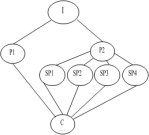 | D. |
8 . Sometimes, when looking at the things that have been lying around for a long time in our lives, we probably realize that those items may be useful to others. With the development of the internet, online communities have figured out a way to generate profit from the sharing of those underused assets. Using websites and social media platforms that facilitate the buying and selling of second-hand goods, it is now easier than ever for peer-to-peer sharing activities to take place. And this is what we call sharing economy.
One of the things consumers appreciate when using or working in the sharing economy is the flexibility. It offers services to people when and where they want them. For those who don’t care for traditional office work, sharing economies do not require professional working environments, so there is no need to put yourself in an atmosphere that unfits for your personality. It allows people to choose flexible atmosphere to work remotely instead of in one physical office space.
A sharing economy helps consumers to earn money by renting out underused goods or resources. For example, you can rent out a home using Airbnb, expensive tools from one’s garage, cars, or even sharing the groceries before going on a holiday. All of these provide a way for items to be resold and repurposed instead of just thrown away. Therefore, it helps to reduce waste and make or save money for the provider and users.
But the sharing economy is not without criticisms. The sharing economy is developing faster than existing regulations or ongoing supervision. One downside is that in many cases there is a lack of regulation to check the products and services exchanged during these deals. Unlike formal companies, unregulated individuals do not follow certain regulations and this can lead to poorer and inconsistent quality of goods and services and a higher risk of fraud. For example, hotels are inspected to assure quality, whereas some apartments for short-term rental online are not. The digitally-driven peer-to-peer nature of the sharing economy services sometimes doesn’t match well with certain regulations, which on the other hand, helps keep the provided services more affordable.
Another problem is related to safety concerns. Most sharing economy platforms are based on trust, as well as ratings by guests and hosts. But sometimes it happens that one uses a car, or rents an apartment and it is totally different than one imagines. After all, we have heard some unpleasant tales of guests and hosts.
The sharing economy definitely has its lovers and haters. Many are not ready to switch to that model, where others are already using more than four platforms in their daily lives.
1. What makes peer-to-peer sharing activities easier?| A.The convenience of the network. |
| B.The development of community. |
| C.People’s keeping underused things. |
| D.People’s demand of second-hand goods. |
| A.sharing economy services are more affordable |
| B.short-term rental apartments are cheaper than hotels |
| C.the current rules can’t regulate the quality of online business |
| D.apartments rental online can’t ensure the safety of the guests |
| A.Supportive. | B.Neutral. | C.Disapproving. | D.Doubtful. |
I: Introduction P: Point Sp: Sub-point (次要点) C: Conclusion
A.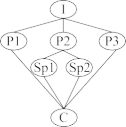 | B. |
C. | D.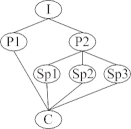 |
9 . What do we mean by responsibility? To put it simply, it is a duty to consider the consequences of our actions. In other words, we have a duty to control our behaviour.
When we are children, we have few responsibilities. Our parents look after us and we generally don’t have to worry about food or shelter. As we grow up, we gradually need to be responsible for more and more things. We learn how to run our own baths, make our own decisions, and realize that we have moral duties. As adults, we are responsible for all aspects of our lives. If there are any problems, we have to handle them ourselves.
We also have responsibilities that go beyond ourselves. Parents have the responsibility to look after their children, ensuring that they have a stable upbringing. Beyond the family, people have a responsibility towards the community as a whole. It is in fact up to us as a society to make this world a safe and pleasant place for everyone.
When we fail in our responsibilities, the consequences are most serious. Teenagers who abandon their studies might ruin their own lives. It is even more horrible to hear about parents who, by not caring for their own children properly, are putting them in danger. Likewise, by not following the traffic rules, careless drivers kill more than a million people around the world every year. Certain professions in our society, such as police officers, exist to protect the public, and the people who do these jobs often risk their own lives in order to do their duty. However, their efforts depend on the support of ordinary people. If we ignore our own responsibilities, society will become dangerous. On a global level, our entire human civilization may be heading towards disaster unless we work together to save our environment.
Furthermore, whether we are shouldering heavy responsibilities, like doctors or lots, or simply taking responsibility for our own learning as students, we will always be judged on how well we perform our duties. For this reason, the hardest part of acting responsibly is admitting that we failed or that we made a mistake. Let’s say you visit your friend’s house and accidentally damage an expensive teapot while your friend is in another room. The honest thing to do is of course to admit your fault and apologize. Because this requires courage, some people take another route: they pretend that nothing happened. Perhaps a broken teapot might not be such a big deal, but in any given situation, we can choose to act responsibly, and it is somewhat through this choice that we decide what our lives are going to be like.
To summarize, responsibilities are an essential part of life since our actions have consequences. Responsibilities aren’t fun, but we can make the burden lighter by sharing them. If everyone considered how their actions would affect themselves and other people, the world would be a better place.
1. The passage tells us that .| A.children have no responsibilities |
| B.adults often risk their own lives in order to do their duty |
| C.our responsible actions would make the world a better place |
| D.responsibilities aren’t fun unless we can make the burden lighter by sharing them |
| A.to control our behaviour | B.to handle problems ourselves |
| C.to affect ourselves and other people | D.to admit our fault and apologize |
| A.Consequence of Responsibility | B.Significance of Responsibility |
| C.Essential Part of Responsibility | D.Development of Responsibility |
I: Introduction P: Point Sp: Sub-point (次要点) C: Conclusion
A.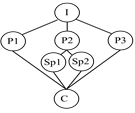 | B. |
C.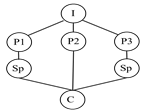 | D. |
10 . Ownership used to be about as straightforward as writing a cheque. If you bought something, you owned it. If it broke, you fixed it. If you no longer wanted it, you sold it or threw it away. In the digital age, however, ownership has become more slippery. Since the coming of smartphones, consumers have been forced to accept that they do not control the software in their devices; they are only licensed to use it. As a digital chain is wrapped ever more tightly around more devices, such as cars and thermostats, who owns and who controls which objects is becoming a problem. Buyers should be aware that some of their most basic property rights are under threat.
The trend is not always harmful. Manufacturers seeking to restrict what owners do with increasingly complex technology have good reasons to protect their copyright, ensure that their machines do not break down, support environmental standards and prevent hacking. Sometimes companies use their control over a product's software for the owners' benefit. When Hurricane Irma hit Florida this month, Tesla remotely updated the software controlling the batteries of some models to give owners more range to escape the storm.
But the more digital strings are attached to goods, the more the balance of control leans towards producers and away from owners. That can be inconvenient. Picking a car is hard enough, but harder still if you have to dig up the instructions that tell you how use is limited and what data you must give. If the products are intentionally designed not to last long, it can also be expensive. Already, items from smartphones to washing machines have become extremely hard to fix, meaning that they are thrown away instead of being repaired.
Privacy is also at risk. Users become terrified when iRobot, a robotic vacuum cleaner, not only cleans the floor but also creates a digital map of the inside of a home that can then be sold to advertisers (though the manufacturer says it has no intention of doing so). Cases like this should remind people how jealously they ought to protect their property rights and control who uses the data that is collected.
Ownership is not about to go away, but its meaning is changing. This requires careful inspection. Devices, by and large, are sold on the basis that they enable people to do what they want. To the extent they are controlled by somebody else, that freedom is compromised.
1. What benefit does it bring to customers if companies control the ownership of products?| A.It provides them with knowledge to prevent hacking. |
| B.It gives them the chance to be protected from danger. |
| C.It enables them to own the copyright of the products. |
| D.It helps them know more about complex technology. |
| A.control other people | B.share the ownership |
| C.inspect devices at any time | D.use devices as one wishes |
| A.customers should buy fewer digital devices |
| B.producers should control property rights |
| C.property rights need to be protected |
| D.better after sales service is required |
I: Introduction P: Point Sp: Sub-point (次要点) C: Conclusion
A.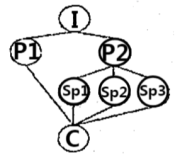 | B. |
C. | D. |



